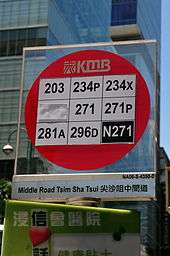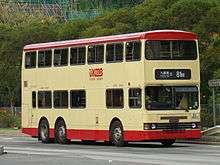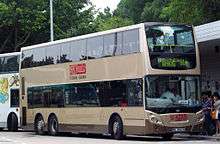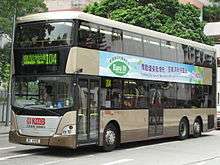Kowloon Motor Bus
 | |
|
Alexander Dennis Enviro 500 MMC | |
| Parent | Transport International Holdings |
|---|---|
| Founded | 13 April 1933 (historical 1921) |
| Headquarters | 9, Po Lun Street, Lai Chi Kok |
| Service type | Bus services |
| Routes | 370 |
| Depots |
Kowloon Bay Depot (K) Lai Chi Kok Depot (L) Sha Tin Depot (S) Tuen Mun Depot (U) |
| Fleet | 3,858 (October 2015)[1] |
| Daily ridership | 2,617,000 (2014 average)[2] |
| Annual ridership | 955,237,000 (2014)[3] |
| Chief executive | Roger Lee (Managing Director) |
| Website |
www |
The Kowloon Motor Bus Company (1933) Limited (KMB; Chinese: 九龍巴士(一九三三)有限公司), is a bus company operating franchised services in Hong Kong, and is the largest bus company in Hong Kong by fleet size and number of bus routes. It is a subsidiary of Transport International Holdings.
History





KMB was founded on 13 April 1933 as a result of the reformation of public transport by the Hong Kong Government. Before the reformation, there were several independent bus operators working on both sides of Victoria Harbour including KMB.
The KMB franchise allowed for the operation of public omnibus service on the Kowloon side as well as the New Territories. By 11 June 1933, KMB had a fleet of 106 single-deck buses.
The founding members of KMB were:
- Tang Shiu-kin (鄧肇堅)
- William Louey Sui Tak (雷瑞德)
- Lui Leung (雷亮)
- Tam Woon Tong (譚煥堂)
- Lam Ming Fan (林明勳)
By 1940, KMB had 140 single-deckers operating on 17 routes. As only a handful of buses survived World War II, some lorries were temporarily converted into buses. By the late 1940s, KMB ridership increased with the huge influx of immigration from China. In 1949, KMB bought 20 Daimler double-deckers from England, becoming the first operator of double-deckers in Hong Kong.
Following the opening of the Cross Harbour Tunnel in 1972, KMB operated a number of cross-harbour routes jointly with CMB, China Motor Bus, the sole bus operator on Hong Kong Island. This marked the first time KMB buses running on the island.
In the same year, KMB began experimenting with buses operating without a fare collector. All passengers would board from the front door and pay the fare by putting money into the collection box next to the driver.
In 1975, the first air-conditioned bus in Hong Kong was put into service by KMB. Following the testing of double-deck air-conditioned buses Victory and Jubilant in the early 1980s, KMB became the world's first operator of such buses. All purchases after 1995 have been for air-conditioned buses.
In 1996, KMB formed a subsidiary, Long Win Bus Company, to provide service on the Lantau Link to the new Hong Kong International Airport and Tung Chung. In 1998, KMB extended its business into mainland China with a co-operative joint venture, Dalian Hong Kong Macau Company Limited.
In 1999, KMB started to operate some KCR Feeder Bus (now MTR Feeder Bus) routes, which are complimentary to passengers of the KCR East Rail (now MTR East Rail Line).
On 8 May 2012, KMB withdrew its last non-air-conditioned buses from service. From then on, all franchised bus routes in Hong Kong have been operated solely by air-conditioned buses.[4]
Innovations
KMB is the first franchised bus company in Hong Kong that achieved the following:
- Air-conditioned franchised bus service (early 1975)
- First super-low-floor easy access (SLF) double-deckers (1997)
- ISO 9001:1994 certification (1999)
- ISO 9001:2000 certification (2002)
- ISO 14001 certification (2001 & 2003)
- Hong Kong Green Mark Certification (2007)
- OHSAS 18001 certification (2019)
Fare
Passengers pay the fare in cash (no change) or using an Octopus card, a smart card payment system. Discounts apply for Octopus users on specified route interchange combinations.[5][6] On buses with sectional fares, the fare decreases as the bus passes each fare zone.
To enable elderly people and eligible persons with disabilities to travel on the general Mass Transit Railway (MTR) lines, franchised buses and ferries any time at a concessionary fare of $2 per trip, starting from 2012. The Scheme aims to help build a caring and inclusive society by encouraging these groups to participate more in community activities.
Fleet
As of 31 December 2014, Kowloon Motor Bus has a fleet of 3,855 air-conditioned buses, of which 3,682 are double-deckers.[3]
The Leyland Lion, Thornycroft CD4LW Cygnet, Commer Superpoise, Dodge G5, Bedford OB, Tilling-Stevens K5LA7, Bedford SB, Seddon MK17 and Ford Thames Trader 4D do not have codes previously. Their buses have assigned the codes since the fleet numbering system began in 1968.
The KMB fleet is divided among four depots in Kowloon and the New Territories. The depot of a bus is identified by the letter K, L, S, or U, and the letter is marked on the bottom left of the driver's windscreen or below windscreen. The assignment scheme is as follows:
- K: Kowloon Bay Depot
- L: Lai Chi Kok (Stonecutter's Island) Depot
- S: Sha Tin (Siu Lek Yuen) Depot
- U: Formerly Un Long (Yuen Long) Depot, currently Tuen Mun Depot
Facilities
KMB buses are equipped with state-of-the-art facilities. Newer buses, such as the Alexander Dennis Enviro 500, have colour CCTV cameras installed whereas older buses use a mirror. A bus stop announcement systems is installed on every bus and informs passengers of the next stop. LCD TVs with programmes are also available on most air-conditioned buses, with programmes are provided by RoadShow.
Routes
KMB serves 370 routes in Kowloon and the New Territories, and operates cross-harbour tunnel routes in cooperation with the two other bus operators, New World First Bus and Citybus.[3]
Route numbering system
Route numbers consist of a number, with an optional letter prefix or suffix. If the digit portion is single- or double-digits, the following scheme is observed:
| Routes | Service areas |
|---|---|
| 1-29 | Urban Kowloon |
| 30-99 | Outside Urban Kowloon/New Territories |
If the number has three digits, the first digit signifies the service, and the remaining two digits follow the above numbering scheme except as indicated:
| Prefix | Service | Notes |
|---|---|---|
| 1 (1xx) | Cross-harbour routes via the Cross-Harbour Tunnel. | |
| 2 (2xx) | Routes using air-conditioned buses only. | This is no longer significant since all routes are air-conditioned. |
| 3 (3xx) | Special cross-harbour tunnel routes with service during the morning and/or evening rush hours only | 307 and 373A are regular full-time routes |
| 6 (6xx) | Cross-harbour routes via the Eastern Harbour Crossing. | |
| 8 (8xx) | Routes serving the Sha Tin Racecourse on horse racing days. | |
| 9 (9xx) | Cross-harbour routes via the Western Harbour Crossing. | |
On buses with printed plaques, the route number and destination are displayed in white on black for non-cross harbour routes and white on red for cross-harbour routes. Buses using dot-matrix displays do not have special background colours.
At bus stops, the route numbers are displayed in black on white for non-cross harbour routes, white on red for cross-harbour routes 1xx, 3xx, 6xx, and 8xx, and white on green for cross-harbour routes 9xx.
The prefix and/or suffix carries additional information about the route:
| Prefix | Meaning | Examples |
|---|---|---|
| N | Overnight routes | N122, N170 |
| T | Limited-service express routes | T270, T277[7] |
| Suffix | Meaning | Examples |
| A through F | There is no clear assignment.
|
|
| K | Routes terminating at a KCR (now MTR East Rail Line, Ma On Shan Line and West Rail Line) station Note that non-K suffixed routes may also terminate at an MTR station: 58X (Mong Kok East Station) |
|
| M | Routes terminating at an MTR station Note that non-M suffixed routes may also terminate at an MTR station: 11 (on both ends: Kowloon and Diamond Hill Stations), 37 (Olympic Station) |
|
| P | Routes that have limited hours or days of service Exceptions: 8P and 276P are regular full-time routes |
69P (06:45 to 08:30 Monday to Saturday except public holidays) |
| R | Recreational routes that run on specific days only | |
| S | Special routes that run on specific days only | 14S and 76S (during Ching Ming[10] and Chung Yeung[11] Festivals) |
| X | Express routes; service may be full-time or limited | 11X, 49X, 68X, 74X, 215X |
| Y | Special route that operates when ferry service is limited to Park Island | Y41 (Operates parallel to NR330, from Tsing Yi MTR Station to and from Park Island) |
Route numbers 1 to 99 are unique only within each service area: (1) Hong Kong island, (2) Kowloon and New Territories, (3) Lantau island. All other route numbers are unique within the territory.
| Route | Hong Kong Island (NWFB/Citybus) | Kowloon and New Territories (KMB) | Lantau (NLB) |
|---|---|---|---|
| 1 | Mount Davis ↔ Happy Valley (Upper) (Citybus) | Star Ferry ↔ Chuk Yuen Estate | Mui Wo ↔ Tai O |
| 23 | North Point Ferry ↔ Pokfield Road (NWFB) | Kwun Tong Ferry ↔ Shun Lee (Circular) | Tung Chung ↔ Ngong Ping |
KMB has no 5xx (Hong Kong Island, air-conditioned bus routes), 7xx (Express bus using the Island Corridor), or Axx or Exx (service to the airport). Currently KMB does not use Mxx to designate buses serving an Airport Express station.
Football team
Kowloon Motor Bus also had a defunct Hong Kong football club, Kowloon Motor Bus Co. It was formed in 1947 and joined Hong Kong First Division League in the 1947/48 season. Nicknamed "Atomic Bus", the team obtained the only two league titles in 1953/54 and 1966/67. The team attained its peak in the 1950s and 1960s when the "South China - Kowloon Motor Bus Co. crash" (南巴大戰) was one of the highlighted rival matches in Hong Kong. In 1970/71, the team faced their first relegation, but was able to stay in the First Division as Jardines quit the league in the following season. However, the team were relegated in 1972/73. It made its last First Division League appearance in 1976/77 bus was relegated after only one season. In 1981, the football team quit the league.
Competitors
- New World First Bus and Citybus - owned by NWS Transport Services Limited
- China Motor Bus - lost franchise to New World First Bus in 1998
- Mass Transit Railway - the railway system in Hong Kong
See also
- Kowloon Motor Bus fleet
- Kowloon Motor Bus fleet numbering
- The Bus Uncle (An incident that took place on a Kowloon Motor Bus and became an internet phenomenon)
- Transport in Hong Kong
References
- ↑ "Average age and respective numbers of buses in the fleet of each franchised bus company" (PDF). Legislative Council. 18 November 2015.
- ↑ "Average Daily Public Transport Passenger Journeys by Public Transport Operator" (PDF). Monthly Traffic and Transport Digest 2015. Transport Department. 2015.
- 1 2 3 "2015 Annual Transport Digest". Transport Department. 2015.
- ↑ Farewell to KMB Non-Air Conditioned Buses Kowloon Motor Bus 10 May 2012
- ↑ "Bus-Bus Interchange System". Kowloon Motor Bus. 2007. Retrieved 2007-12-06.
- ↑ "KMB fares cut on day trains reduce prices". The Standard. 2007. Retrieved 2007-12-06.
- ↑ http://www.kmb.hk/en/news/press/archives/news201408222063.html
- ↑ http://www.kmb.hk/en/news/press/archives/news201406242042.html
- ↑ http://www.kmb.hk/en/news/press/archives/news201407022048.html
- ↑ http://www.kmb.hk/en/news/press/archives/news201403212019.html
- ↑ http://www.kmb.hk/en/news/press/archives/news201210161781.html
General
- 香港足球總會九十週年紀念特刊
Further reading
- Ko, Tim-keung (2013). 80 Years with KMB (1933-2013). Hong Kong: Joint Publishing. ISBN 9789620434907.
External links
| Wikimedia Commons has media related to Kowloon Motor Bus. |